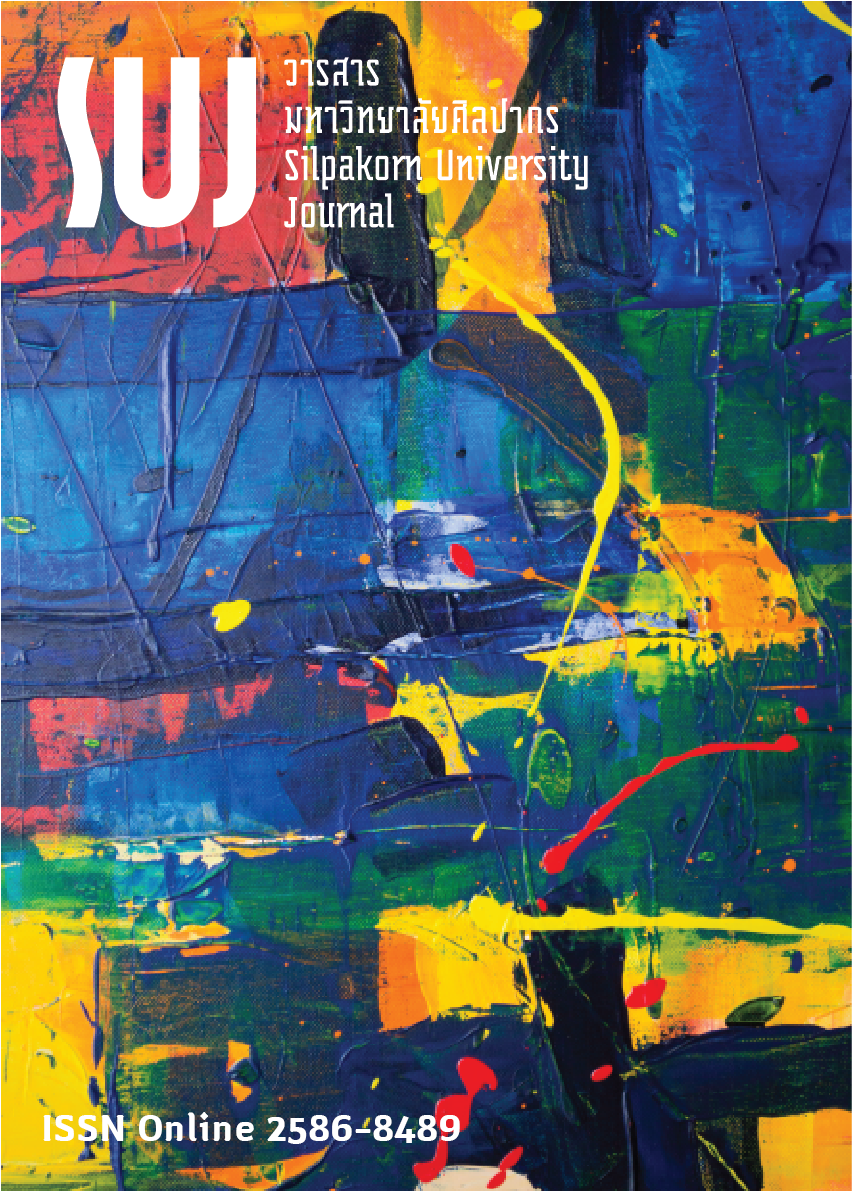อิทธิพลของความได้เปรียบในการแข่งขันอย่างยั่งยืนที่อยู่ในฐานะตัวแปรปฏิสัมพันธ์ระหว่างการมุ่งเน้นการตลาดสู่ผลการดำเนินงานของอุตสาหกรรม อาหารทะเลแช่แข็งไทย (Influence of sustainable competitive advantage as the interacting variables between the market orientation and the performance of Thai frozen seafood industry)
Main Article Content
Abstract
งานวิจัยนี้มีวัตถุประสงค์เพื่อ (1) ศึกษาระดับของการมุ่งเน้นการตลาด ความได้เปรียบในการแข่งขันอย่างยั่งยืน และผลการดำเนินงานของอุตสาหกรรมอาหารทะเลแช่แข็งไทย และ (2) ศึกษาอิทธิพลของความได้เปรียบในการแข่งขันอย่างยั่งยืนที่เป็นตัวแปรเชื่อมโยงความสัมพันธ์ระหว่างการมุ่งเน้นการตลาดกับผลการดำเนินงานของอุตสาหกรรมอาหารทะเลแช่แข็งไทย โดยงานวิจัยนี้เป็นการวิจัยเชิงปริมาณด้วยวิธีการวิจัยเชิงสำรวจ กลุ่มตัวอย่าง คือ สถานประกอบการอุตสาหกรรมอาหารทะเลแช่แข็งไทย จำนวน 118 ตัวอย่างและแบบสอบถาม ได้รับการตอบกลับทุกฉบับ สถิติที่ใช้ในการวิจัย คือ วิเคราะห์ด้วยค่าร้อยละ ค่าเฉลี่ย ส่วนเบี่ยงเบนมาตรฐาน และการวิเคราะห์สมการโครงสร้างโดยใช้โปรแกรม PLS Graph 3.0 ผลการวิจัยพบว่า (1) การมุ่งเน้นการตลาด ความได้เปรียบในการแข่งขันอย่างยั่งยืน และผลการดำเนินงานขององค์การมีค่าเฉลี่ยโดยรวมอยู่ในระดับมาก โดยมีค่าเฉลี่ยเท่ากับ 3.90, 3.89 และ 3.78 ตามลำดับ และ (2) การสร้าง ความแตกต่าง การเป็นผู้นำด้านต้นทุน และการตอบสนองรวดเร็วมีอิทธิพลต่อการเชื่อมโยงความสัมพันธ์ระหว่างการมุ่งเน้นการตลาดกับผลการดำเนินงานขององค์การ สามปัจจัยนี้เป็นอิทธิพลของความได้เปรียบในการแข่งขันอย่างยั่งยืน ผู้วิจัยพบว่า เมื่อองค์การมีการสร้างกลยุทธ์การมุ่งเน้นการตลาดอย่างต่อเนื่องก็จะทำให้องค์การเกิดความได้เปรียบในการแข่งขันอย่างยั่งยืนและจะนำมาซึ่งผลการดำเนินงานที่เพิ่มสูงขึ้นอย่างต่อเนื่องเช่นกัน
This research aims to (1) study the level of marketing orientation, sustainable competitive advantage and performance of Thai frozen seafood industry and (2) study the influence of sustainable competitive advantage as the interactive variable between marketing orientation and the performance of Thai frozen seafood industry. This quantitative research employs the population-based survey methodology with 118 Thai frozen seafood samples. All questionnaires were all completed and returned. The statistical uses included percentage, mean and standard deviation as well as an analysis of structural equations via PLS Graph 3.0. The research revealed that the marketing orientation, the sustainable competitive advantage and the performance of the organization have averagely high level at 3.90, 3.89 and 3.78, respectively. The attributes of making difference, capital leader and quick response have a positive effect on the interaction between the marketing oriented approach and organizational performance. These three attributes contributes to the sustainable competitive advantage. To conclude, once the marketing strategies were continuously developed, the organization will gain a sustainable competitive advantage, and the organizational performance will be continuously promoted.
Article Details
References
Chin, W. W. (2001). PLS graph user’s guide version 3.0. [Online]. Retrieved January 8, 2018 from http://www.spss-pasw.ir/upload/images/ei8gx66re11tenmq0sm.pdf
Department of Industrial Work. (2017). Factory Data Area. [Online]. Retrieved January 1, 2018 from http://www.diw.go.th/hawk/content.php?mode=data1search
Ge, G. L., & Ding, D. Z. (2005). Market orientation, competitive strategy and firm performance: An empirical study of Chinese Firms. Journal of Global Marketing, 18(3): 115-142.
Herlambang, T., Afnan, E., Sudiro, A. & Noermigati. (2013). Analysis of competitive advantage in the perspective of resources based view. Journal of Business and Management, 10(1): 30-49.
Ismail, A. I., Rose, R. C., Abdullah, H. & Uli, J. (2010). The relationship between organizational competitive advantage and performance moderated by the age and size or firms. Asian Academy of Management Journal, 15(2): 157-173.
Kumar, V., Jones, E., Venkatesan, R. & Leone, R. P. (2011). Is market orientation a source of sustainable competitive advantage or simply the cost of competing?. Journal of Marketing, 75: 16-30.
Likert, R. A. (1932). A technique for the measureSment of attitudes. Archives of Psychology, 140: 5-53.
Newbert, S. L. (2008). Value, rareness, competitive advantage, and performance: A conceptual-level empirical investigation of the resource-based view of the firm. Strategic Management Journal, 29: 745-768.
Office of International Commercial Affairs in the Hague. (2015). Thai seafood and products industry in the European market. [Online]. Retrieved July 21, 2018, from http://www.ditp.go.th/ contents_attach/93868/93868.pdf
Safarnia, H., Akbari, Z., & Abbasi, A. (2011). Review of market orientation & competitive advantage in the industrial estates companies (Kerman, Iran): Appraisal of model by Amos Graphics. World Journal of Social Sciences, 1(5): 132-150.
Salyova, S., Janka, T. P., Nedelova, G. & Dado, J. (2015). Effect of marketing orientation on business performance: A study from Slovak foodstuff industry. Procedia Economics and Finance, 34: 622-629.
Suardhika, I. N. & Suryani, N. K. (2016). Strategic role of entrepreneurial marketing and customer relation marketing to improve competitive advantage in small and medium enterprises in Bali Indonesia. International Journal of Management and Commerce Innovations, 4(1): 628-637.
Wang, H., Han, P. & Liu, W. (2018). How to improve sustainable competitive advantage from the distributor and the supplier networks: Evidence form the paper-making industry in China. Sustainability, 10: 1-13.
Yamane, T. (1973). Statistics: An introductory analysis. New York: Harper & Row.
Yuniari, W., Yasa, N. N. K. & Giantari, I. G. A. (2018). The role of competitive advantage in mediating the influence of market orientation on internationalization and marketing performance: A study on Silver Craft SMEs in Celuk Village, Bali Province. European Journal of Business and Social Sciences, 6(10): 55-71.
Zhou, K. Z., Brown, J. R. & Dev, C. S. (2009). Market orientation, competitive advantage, and performance: A demand-based perspective. Journal of Business Research, 62: 1063-1070.

